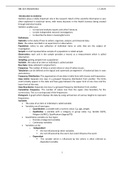Class notes
SBL 321: Biostatistics well written and explained
- Course
- Institution
Introduction to statistics Statistics plays a vitally important role in the research. Much of the scientific information is very often explained in statistical terms, with many decisions in the Health Sciences being created through statistical studies Statistics enables you: o to read and eval...
[Show more]



